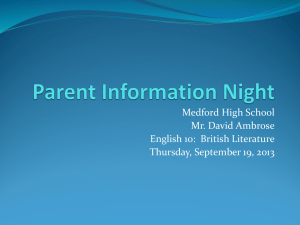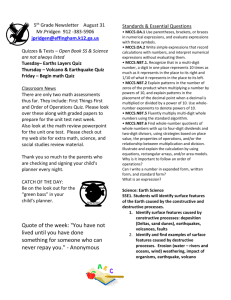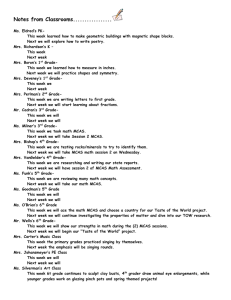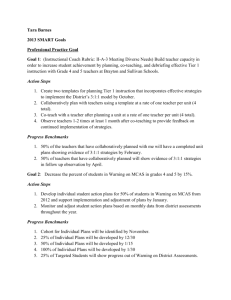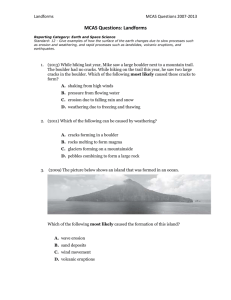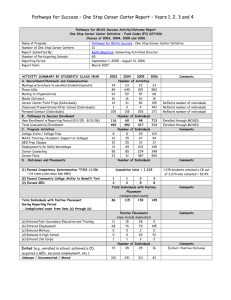Chemical Interactions
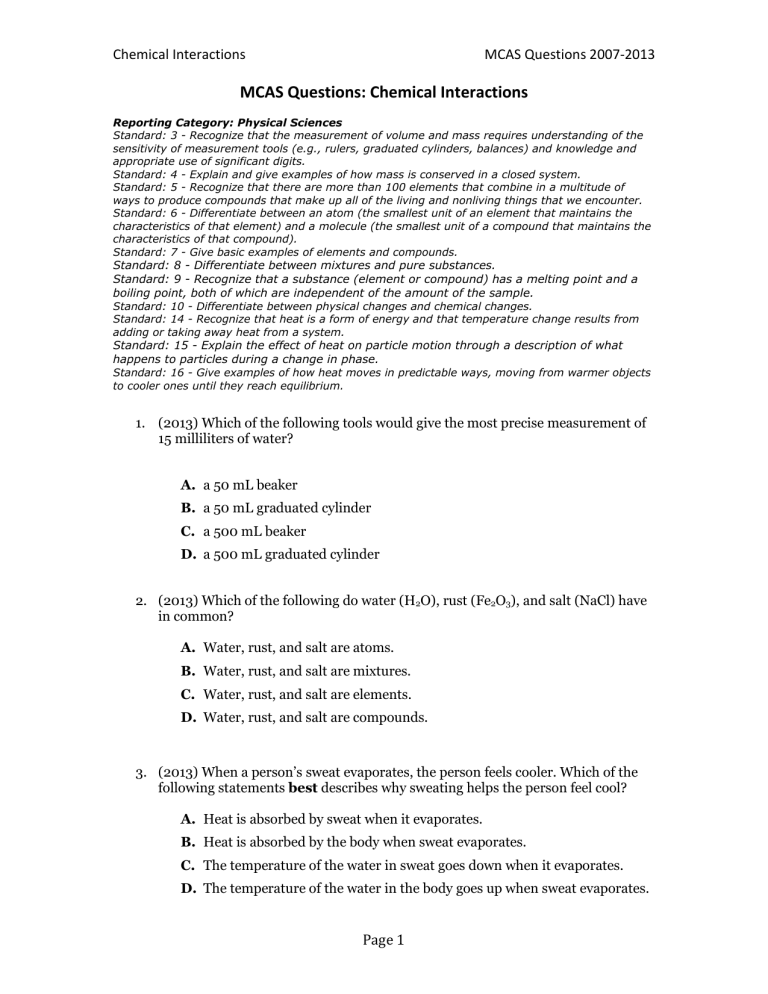
Chemical Interactions MCAS Questions 2007-2013
MCAS Questions: Chemical Interactions
Reporting Category: Physical Sciences
Standard: 3 - Recognize that the measurement of volume and mass requires understanding of the sensitivity of measurement tools (e.g., rulers, graduated cylinders, balances) and knowledge and appropriate use of significant digits.
Standard: 4 - Explain and give examples of how mass is conserved in a closed system.
Standard: 5 - Recognize that there are more than 100 elements that combine in a multitude of ways to produce compounds that make up all of the living and nonliving things that we encounter.
Standard: 6 - Differentiate between an atom (the smallest unit of an element that maintains the characteristics of that element) and a molecule (the smallest unit of a compound that maintains the characteristics of that compound).
Standard: 7 - Give basic examples of elements and compounds.
Standard: 8 - Differentiate between mixtures and pure substances.
Standard: 9 - Recognize that a substance (element or compound) has a melting point and a boiling point, both of which are independent of the amount of the sample.
Standard: 10 - Differentiate between physical changes and chemical changes.
Standard: 14 - Recognize that heat is a form of energy and that temperature change results from adding or taking away heat from a system.
Standard: 15 - Explain the effect of heat on particle motion through a description of what happens to particles during a change in phase.
Standard: 16 - Give examples of how heat moves in predictable ways, moving from warmer objects to cooler ones until they reach equilibrium.
1.
(2013) Which of the following tools would give the most precise measurement of
15 milliliters of water?
A.
a 50 mL beaker
B.
a 50 mL graduated cylinder
C.
a 500 mL beaker
D.
a 500 mL graduated cylinder
2.
(2013) Which of the following do water (H
2 in common?
O), rust (Fe
2
O
3
), and salt (NaCl) have
A.
Water, rust, and salt are atoms.
B.
Water, rust, and salt are mixtures.
C.
Water, rust, and salt are elements.
D.
Water, rust, and salt are compounds.
3.
(2013) When a person’s sweat evaporates, the person feels cooler. Which of the following statements best describes why sweating helps the person feel cool?
A.
Heat is absorbed by sweat when it evaporates.
B.
Heat is absorbed by the body when sweat evaporates.
C.
The temperature of the water in sweat goes down when it evaporates.
D.
The temperature of the water in the body goes up when sweat evaporates.
Page 1
Chemical Interactions MCAS Questions 2007-2013
4.
(2013) Oxygen and iron combine chemically to form rust. Rust is classified as which of the following?
A.
an atom
B.
a compound
C.
an element
D.
a mixture
5.
(2012) The picture below shows a beaker containing a clear liquid with a temperature of 20°C.
A blue powder is added to the liquid. Which of the following pictures provides the best evidence that the change to the liquid is physical, not chemical?
A.
B.
C.
D.
Page 2
Chemical Interactions MCAS Questions 2007-2013
6.
(2011) In the chemical reaction shown below, all of the HCl and Zn will react to form H
2
and ZnCl
2
.
Which of the following statements describes the result of this reaction?
A.
The hydrogen gas will have a mass of zero.
B.
The zinc chloride will have less mass than the zinc.
C.
The mass of the products will equal the mass of the reactants.
D.
The mass of the hydrogen atoms will decrease in the products.
7.
(2011) Which of the following is produced when two or more elements combine in a chemical reaction?
A.
atom
B.
compound
C.
mixture
D.
solution
Page 3
Chemical Interactions MCAS Questions 2007-2013
8.
(2011) A teacher put one test tube of 50°C liquid and one test tube of 10°C liquid into a 20°C water bath, as shown in the diagram below.
Which of the following diagrams best represents the directions that heat will move when the test tubes are placed into the water bath?
A.
B.
C.
D.
Page 4
Chemical Interactions MCAS Questions 2007-2013
9.
(2010) Four different-colored blocks are placed outside in bright sunlight. The blocks are identical except for color. The diagram below shows the amount of light reflected from each block.
Which block will increase in temperature most rapidly?
A.
block 1
B.
block 2
C.
block 3
D.
block 4
10.
(2010) What is the smallest unit of a chemical compound that still has the properties of that compound?
A.
a nucleus
B.
a molecule
C.
an element
D.
an atom
11.
(2009) Which of the following is an example of a container that is filled with a pure substance rather than with a mixture?
A.
a tire filled with air
B.
a jar filled with salt water
C.
a balloon filled with helium
D.
a glass filled with chocolate milk
Page 5
Chemical Interactions MCAS Questions 2007-2013
12.
(2009) The table below shows the number of each kind of atom that makes up one molecule of the compounds sucrose and ethanol.
Which of the following is the same for both compounds?
A.
the mass of each molecule
B.
the length of each molecule
C.
the types of atoms in each molecule
D.
the number of atoms in each molecule
13.
(2009) The picture below shows a demonstration of water changing from the liquid phase to the gas phase as it boils in a beaker.
Which of the following statements explains why this demonstration cannot be used to prove that matter is conserved during a change of phase?
A.
The change of phase is incomplete.
B.
Water is changing both phase and temperature.
C.
Water in the gas phase is lighter than liquid water.
D.
The change of phase is taking place in an open system.
Page 6
Chemical Interactions MCAS Questions 2007-2013
14.
(2009) During an investigation, Steven filled two cups with the same amount of water and placed them in a 20°C room for 30 minutes. Cup 1 was filled with 5°C water. Cup 2 was filled with 35°C water. The diagram below shows the temperatures of the cups at the beginning of the investigation.
Which of the following graphs shows how the temperatures of the two cups of water most likely changed over 30 minutes?
A.
B.
C.
D.
Page 7
Chemical Interactions MCAS Questions 2007-2013
15.
(2009) A student is given a sample of an unknown liquid to test in the laboratory.
The student thinks that the liquid is water. Which of the following physical properties of the sample is most helpful to determine if the liquid is water?
A.
color of the liquid
B.
mass of the liquid
C.
volume of the liquid
D.
boiling point of the liquid
16.
(2008) Which of the following is formed when two elements combine chemically?
A.
an atom
B.
a compound
C.
an electron
D.
a mixture
17.
(2008) Ms. Bristol measured the mass of a closed beaker containing several ice cubes. The mass was 100 g. An hour later, after the ice cubes had melted, Ms.
Bristol measured the mass of the beaker again.
What was the mass of the beaker of water the second time?
A.
50 g
B.
75 g
C.
100 g
D.
125 g
Page 8
Chemical Interactions MCAS Questions 2007-2013
18.
(2008) The diagram below shows how a change in temperature affects the physical state of a substance. Each of the labeled points represents the same substance at a different temperature.
Which point represents the substance in the physical state with the particles moving the least?
A.
point W
B.
point X
C.
point Y
D.
point Z
19.
(2008) Sugar is composed of carbon, hydrogen, and oxygen. Sugar is an example of which of the following?
A.
an atom
B.
a compound
C.
an electron
D.
a mixture
20.
(2008) The surface of a heated metal object measures 120°C. It is dropped into a bucket filled with water measuring 10°C.
Which of the following is most likely to occur?
A.
Both the water and metal will adjust to the same temperature below 10°C.
B.
The water and metal will adjust to different temperatures above 120°C.
C.
The water will remain the same temperature, but the metal will cool to
10°C.
D.
The water and metal will adjust to the same temperature between 10°C and 120°C.
Page 9
Chemical Interactions MCAS Questions 2007-2013
21.
(2008) A pot of cold water was heated on a stove until the water boiled. Which of the following best explains why the water was able to boil?
A.
The hot stove absorbed cold from the pot.
B.
The cold water absorbed heat from the pot.
C.
The hot stove gave off heat to the surrounding air.
D.
The cold water gave off cold to the surrounding air.
22.
(2007) The law of conservation of mass can be demonstrated by a chemical reaction. Which of the following models of a chemical reaction best represents the law of conservation of mass?
A.
B.
C.
D.
23.
(2007) Which of the following is an example of a physical change but not a chemical change?
A.
A log gives off heat and light as it burns.
B.
A tree stores energy from the Sun in its fruit.
C.
A penny lost in the grass slowly changes color.
D.
A water pipe freezes and cracks on a cold night.
Page 10
Chemical Interactions MCAS Questions 2007-2013
24.
(2007) Which of the following is an example of the formation of a mixture?
A.
rust forming on an iron nail
B.
sugar crystals dissolving in water
C.
sodium and chlorine forming table salt
D.
hydrogen and oxygen reacting to produce water
25.
(2007) Laura adds 50 mL of boiling water to 100 mL of ice water. If the 150 mL of water is then put into a freezer, at what temperature will the water freeze?
A.
0°C
B.
15°C
C.
37°C
D.
50°C
26.
(2007) Which of the following substances can be separated into several elements?
A.
nitrogen
B.
zinc
C.
air
D.
aluminum
27.
(2007) Which of the following is a characteristic of all chemical changes?
A.
A different state of matter is produced.
B.
Some mass is converted to energy.
C.
Some form of light is given off.
D.
A new material is formed.
Page 11
Chemical Interactions MCAS Questions 2007-2013
28.
(2007) What is the smallest unit of an element that still has the properties of that element?
A.
an atom
B.
a compound
C.
an electron
D.
a molecule
Page 12
Chemical Interactions MCAS Questions 2007-2013
Open Response Questions
1. (2013) A scientist has three unlabeled samples of pure metals. He wants to determine the identity of each metal. a.
Identify which one of the following properties the scientist should use to determine the identity of the pure metal in each sample: color, melting point, mass, or volume. b.
Explain why the property you identified in part (a) can be used to determine the identity of the pure metal in each sample.
The scientist cuts each of the samples of pure metal into two smaller pieces. c.
Is the property that is used to determine the identity of the metal affected when each sample is cut into two pieces? Explain your answer.
The scientist can also use density to determine the identity of the pure metal in each sample. d.
Describe how the scientist can determine the density of the pure metal in each sample.
Page 13
Chemical Interactions MCAS Questions 2007-2013
2. (2010) The picture below shows a sample of liquid in a graduated cylinder. a.
Identify what property of the sample is being measured with the graduated cylinder. b.
Identify the measurement of the sample in the graduated cylinder. Include units and use the correct number of significant digits in your answer.
The entire sample was transferred to a 100 mL beaker, as shown below. c.
Identify the measurement of the sample in the beaker. Include units and use the correct number of significant digits in your answer. d.
Explain why the measurements would be recorded differently when the sample is in the graduated cylinder and when it is in the beaker.
Page 14
Chemical Interactions MCAS Questions 2007-2013
3. (2007) The diagram below shows a model in an open container. The model represents the arrangement of particles of matter in a solid phase. a.
Draw a diagram showing the arrangement of these particles in a liquid phase.
Explain why the particles have this arrangement. Be sure to describe the energy of the particles. b.
Draw a diagram showing the arrangement of these particles in a gas phase.
Explain why the particles have this arrangement. Be sure to describe the energy of the particles.
Page 15
1.
B
2.
D
3.
A
4.
B
5.
A
6.
C
7.
B
8.
C
9.
D
10.
B
Chemical Interactions MCAS Questions 2007-2013
MCAS Questions: Chemical Interactions
Multiple Choice Answers
11.
C
12.
C
13.
D
14.
C
15.
D
16.
B
17.
C
18.
A
19.
B
20.
D
21.
B
22.
A
23.
D
24.
B
25.
A
26.
C
27.
D
28.
A
Open Response Answers
1. Pure Metals
Score Point 4
Page 16
Chemical Interactions
Score Point 4
MCAS Questions 2007-2013
Page 17
Chemical Interactions
Score Point 3
MCAS Questions 2007-2013
Score Point 2
Page 18
Chemical Interactions
Score Point 1
MCAS Questions 2007-2013
Page 19
Chemical Interactions
Score Point 0
MCAS Questions 2007-2013
Page 20
Chemical Interactions
2. Liquid Measurement
Score Point 4
MCAS Questions 2007-2013
Score Point 4
Page 21
Chemical Interactions
Score Point 3
MCAS Questions 2007-2013
Score Point 2
Page 22
Chemical Interactions
Score Point 1
MCAS Questions 2007-2013
Score Point 0
Page 23
Chemical Interactions
3. Particles of Matter
Score Point 4
MCAS Questions 2007-2013
Page 24
Chemical Interactions
Score Point 4
MCAS Questions 2007-2013
Score Point 3
Page 25
Chemical Interactions
Score Point 2
MCAS Questions 2007-2013
Score Point 1
Page 26
Chemical Interactions
Score Point 0
MCAS Questions 2007-2013
